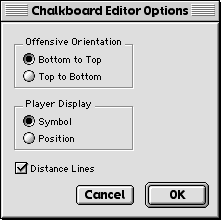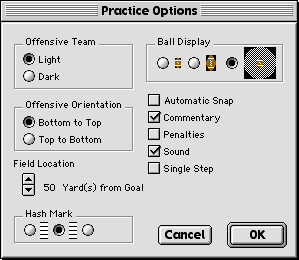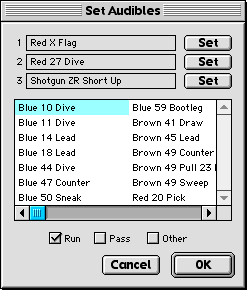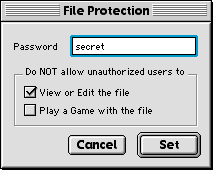CHALKBOARD EDITOR
PlayMaker Football's™ Chalkboard Editor is a sophisticated play creation environment that puts the power of football
play design at your fingertips, allowing you to diagram plays just like the pros. These plays are stored in a "playbook"
allowing the plays to be used in game situations.
To design plays in the Chalkboard Editor, you should first create your own team in the Team Draft (see the Team Draft section
in this manual). Once you've created a team, you can design custom plays for it in the Chalkboard Editor.
Before you start designing your own plays it's probably a good idea to look at some of the playbooks included with PlayMaker
Football™. In fact, one of the easiest ways to create a custom playbook is to copy one of the playbooks included with
PlayMaker Football™ and make modifications to the existing plays.
GETTING STARTED
Before you can create plays you will need to get a team to execute your plays, and a playbook to save your plays in. If you
have not yet created a team, please follow the instructions in the Team Draft section of this
manual, or use one of the already created teams that come with the PlayMaker Football™.
- At the main screen select Chalkboard Editor from the
File
menu.
- A new playbook is automatically created for you when you enter the Chalkboard Editor.
At any time, you can create a new playbook by selecting New Playbook from the File menu.
If you have already created a playbook choose Open Playbook.
- When the playbook is loaded, the program will also attempt to automatically open the last team you used in the Chalkboard
Editor, or a team with the same name as the the Playbook, or the default team.
After the team and playbook load, the players will appear, lined up, on the chalkboard represented by their assigned symbols.
When the screen first appears, the offense is at the bottom half, and the defense is at the top half.
You will see a blank "chalkboard" on the screen and a palette of player instruction icons at the bottom of the screen. The
solid line across the middle of the screen is the line of scrimmage. The dotted lines indicate 5 yard distances. The current
play names for each side will be indicated on the field at the top and bottom of the screen.
All plays that you create and save will be kept in your Playbook. Each playbook can hold about 250 plays.
Having created a team and playbook,
the next time you use the Chalkboard Editor, you can simply select Open
Playbook from the File menu, and the program will automatically load both
the playbook and team with the same name.
LOADING PLAYS
If you are working with a playbook that already contains plays, you can load the plays so they appear on the chalkboard by
taking the following steps:
- Select Load Play... from either the Offense or Defense menu.
-
Click the check boxes for the play category you want.
- A list of plays will appear. Scroll through the list, and when you find the play you want
click the play name, then click the Load button.
When the play has loaded, the name will appear on the chalkboard and the players will line up according to the play diagram.
HOW PLAYS ARE DESIGNED
When a coach creates a play for his team he draws a diagram with specific instructions for his players, so that when the play
is run, each player knows exactly what he is supposed to do. Coordination, timing and teamwork are crucial, and a play may
need to be practiced and refined many times before it is incorporated into the playbook.
Using PlayMaker Football™'s Chalkboard Editor you can diagram plays in much the same way as an actual football coach
does. The mouse is used to move individual players into their starting positions and to draw paths for them. The palette at
the bottom of the screen contains icons which are used to assign detailed instructions to your players.
Once you have moved your players into position and diagrammed paths and instructions for them, you can try the play on the
Practice Field. If it isn't working quite right, you can go back to the Chalkboard, make the necessary modifications and try
again on the Practice Field. When you're happy with the results you can save the play so it is a permanent part of your
team's playbook.
CHALKBOARD BASICS
DISPLAY OPTIONS: Select Options from the File menu to adjust the Chalkboard Editor display.

SELECTING PLAYERS: Plays are designed by assigning a series of patterns and/or instructions to individual
players. To select a player to receive instructions, simply point to that player's symbol and
click it once. A small box will appear around the player's symbol, and if any patterns have
already been assigned to him, they will also appear.
To unselect a player simply click on another player, or anywhere on the chalkboard.
MOVING PLAYERS: The first step in designing a play is to move the players into a starting formation. Select
the desired player, hold the button down and drag him to his new position on the field.
Release the button
to place the player.
(Note: To move the center, hold down the Command key while dragging him.)
PLAYER INFORMATION: To view a player's name and attributes, double-click his
symbol and his Info window will appear. When you are finished, click the OK button.
ALTERNATES: If a player can alternate with a substitute, the Alternate button will be active in his Info
window. Click the Alternate button to "bring in" the alternate.
Click the OK button to use the alternate player in the current play. The alternate player always
switches with his counterpart starter. For example, if the kicker is brought in, the quarterback will go out.
ASSIGNING INSTRUCTIONS: To assign instructions to a player, select him and
click on the desired icon. All player instructions are in the form of icons which are at the
bottom of the chalkboard screen. To assign an instruction to a player simply select the player and
click on the desired instruction icon. Except for Pause, Shading, and the special case of Read
Offense and Zone, only one instruction can be assigned to a player. However, you may assign several pattern segments to a
player before giving him the instruction.

PATTERNS: To assign a running pattern to any player, select the player and
hold down the Option key.
The cursor will turn into a symbol of two football cleats.
With the Option key held down move the cursor
to the first intended destination, then
hold down the mouse button.
A line will appear indicating the path the player will take.
With the mouse button held down you can adjust the position of the line by moving the mouse. When you let go of the button the path will be placed.
You can attach another path segment to the same player by repeating the steps for placement of the path. In this way, you can
chain up to 10 path segments together for each player. You can also put enter the shift-lock keystrokes to speed the entry of
multiple path segments for a given player.
When a play is run, the player will simply follow the path you set for him. If a player reaches the end of his path during a
play he will continue running in the same direction until the play ends. If a ball carrier reaches the end of his path he
will try to continue gaining yards, evading tacklers as best he can.

SCROLLING & SIZING THE CHALKBOARD: You can scroll the chalkboard with the horizontal or vertical scroll bars.
These function as they would in any application: clicking on the arrows or page controls scrolls the surface in the
corresponding direction. he chalkboard will also scroll automatically when dragging players and paths beyond the left, right top or
bottom borders of the chalkboard. Additionally, it will scroll if the Option key is being
held down and the cursor is moved beyond the borders of the chalkboard.
You can resize the chalkboard by clicking on the grow area, dragging the outline of the window to its new size, and then releasing the mouse.
FORMATIONS AND PRE-DESIGNED PLAYS
When a new playbook is created it already has several pre-designed special team plays, such as punts, punt returns, kickoffs,
kick returns, PAT tries, etc. You are free to modify these plays or use them as they are.
In addition to these plays, a new playbook also contains a variety of standard football formations for both offense and
defense. These formations are classified in the Other category. The formations contain no player instructions, they merely
provide a convenient way to get your players in position for each new play you design.
After opening a playbook you can use the formations by following these steps:
- Select Load Play from either the Offense or Defense menu.
- Make sure the radio button next to Normal Play is selected, and click on the Other check
box.
- You will see a list of play names. Scroll down to the bottom of the list until you see a series of names labeled
"Formation" and enclosed in brackets. These are formations without any player instructions. To load a formation select a
"Formation" play and click the Load button.
- Once the formation is loaded, you can assign instructions to the players, and even move the players on the chalkboard to
modify the formation. When you are ready to save the play, select Save Play As... in the Offense or Defense menu (whichever
is appropriate) and name the play. Make sure you save it under the appropriate play category.
PRACTICE FIELD
To make sure your plays work correctly it's a good idea to try them out on the Practice Field.
- From the chalkboard select Practice Field... in the File menu.
The view will switch from the chalkboard to the playing field, and you'll see the players line up according to their assigned
positions on the chalkboard (if you haven't diagrammed or loaded any plays yet, select Load Play from the Offense and Defense
menus).
- To run a play,
click the mouse button or press the Return or Enter keys.
When the play ends, the players will line up again, ready to try once more. You may want to run a play several times, since
the outcome won't always be the same each time, due to a variety of random events, including players slipping, missing
blocks, etc.
HASH MARKS IN PRACTICE: The Practice Field lets you try out your plays from the center of the field, or
either hash mark. You can set the hash mark that the ball will be centered on in the Practice Options Dialog by selecting
Options Info... under the File menu.
DIFFERENT OPPOSING PLAYS: If you are trying out a new offensive play you will probably want to see how it
performs against different defenses, and for a new defense you will want to test it against different offenses. While your
team is on the Practice Field you can load different offensive and defensive plays by selecting Load Play... in either the
Defense or Offense menus.
SNAPPING THE BALL: To snap the ball on the Practice Field,
click the mouse button or press the Enter key.
STOPPING A PLAY: You can terminate a play at any time simply by
pressing the Esc or Clear key.
VIEWING A PLAYER: If you need to look at a player's position and abilities
while on the Practice Field, double-click
the desired player. (Note: certain play instructions will cause defensive
players to readjust their positions. If you try to view one of these players
while he is in an adjusted position, he will "jump" back to his diagrammed
position.)
BACK TO THE CHALKBOARD EDITOR: You can leave the Practice Field and return to the Chalkboard Editor at any
time simply by selecting Practice Field in the File menu (this "turns off" the Practice Field).
OPTIONS: You can configure a variety of conditions on the Practice Field by selecting Options Info... in the
File menu while the Practice Field is on the screen.

PENALTIES: It's a good idea to test all of your plays on the Practice Field with the Penalties option turned
on, so you can eliminate any illegal formation, offsides and ineligible man downfield penalties before you play a game.
SINGLE STEP: This option allows you to view a play one step at a time. When this option is selected,
press the Return or Enter keys.
to advance the play one step. This
is a good way to observe individual players and complex blocking schemes in action.
SAVING PLAYS
Once you have finished working on a play you should save it to your playbook so it can be used in a game or called up for
later modification.
- When you are done working with a play, select Save Play As... in the Offense or Defense menu, whichever corresponds to
the kind of play you want to save, and the Save window will appear.
PLAY NAME: The play must have a name in order for you to save it. Simply position the cursor at the text box
and type a name.
PLAY CATEGORY: Before you can save a play it must also be assigned to a particular category. Just below the
play name box are two buttons and a series of check boxes. Each button activates a different set of check boxes. The Normal
Play button activates the Run, Pass, and Other check boxes. The Situation Play button activates the EP, Kickoff and Safety
check boxes.
When the appropriate button is selected, simply check the box, or boxes, which are appropriate for the play you are saving.
To assign a play to the Run category for example, click the Normal Play button, then
click the Run check box. You can click more than one active check
box if you want to save the play under more than one category.
The categories make it easy to search for plays when playing a game, and in the case of Situation Plays, define the play type
for the computer coach.
Making Changes to Preexisting Plays: If you make changes to a play that's already saved, and you don't want to alter the play
category, name or strategy settings, simply select Save Play in the Offense or Defense menu. The newly altered version of the
play will replace the existing version on the disk and all other settings will remain the
same.
RENAME PLAY
If you want to change the name of a play that has already been saved to a playbook, follow these steps:
- To change the name of a play it must first be loaded into the Chalkboard Editor.
- Select Rename Play in the Offense or Defense menu (whichever is appropriate).
- Type a new name for the play.
-
Click Rename to change the name.
IMPORT PLAYS
If you want to copy one or more plays from one playbook to another follow
these steps:
- Make sure you have opened the destination playbook into which you want to import plays.
- Select Import Plays... in the Offense or Defense menu (whichever is appropriate),
and click OK at the prompt to select a source playbook from which you want to export plays.
- A list of playbooks will appear. Select the source playbook.
Plays that are transferred will be copied from the source playbook
to the destination playbook. Click the Open button to proceed.
- A list of plays from the source playbook will appear. To
transfer a play simply click its name then click the Import button.
When you are finished, click the Done button.
PRINTING
There are two options available at the Chalkboard Editor that allow you
to print your plays. When printing, always make sure your printer
is turned on and loaded with paper.
- To print the play that is currently displayed on the chalkboard, select
Print Play from the Offense or Defense menu (whichever is appropriate to
the play you want printed).
-
To print all or some of the plays in a playbook, select Print Playbook
from the Offense or Defense menu. All of the plays for the Offense or Defense
will be printed.
SETTING AUDIBLES
Audibles are plays that can be called at the line of scrimmage after the
quarterback has a chance to see the defensive setup. A playbook can
have any three of its offensive plays defined as audibles, which are selected
during a game by typing the 1, 2 or 3 keys.
To define which plays are to be used as audibles select Set Playbook
Audibles... from the File menu, and the Set Audibles window will appear:

Find the play you want for an audible in the scrolling window, highlight
it with the mouse then click the appropriate Set button to assign it to
either the 1, 2 or 3 key. Even though a play has been selected as
an audible, it can still be called as a regular play from the huddle.
PASSWORD PROTECTION
A playbook is the most sacred document a football team has. A well
designed playbook can make the difference between a championship team and
a losing team. To prevent your hours of creative football genius
from being copied by opposing coaches and scouts, PlayMaker Football™ lets
you password protect your playbook.
If you want to protect your playbook, select Protect Playbook... from
the File menu.

When the window appears type a password (make sure you don't forget
it!) and select the level of protection that you want by clicking the appropriate
check boxes.
SAVING PLAYBOOKS
Any changes made to a playbook (saving plays, renaming plays, setting protection, etc.)
will be made permanent if and only if you save your playbook between the time the change is made
and you leave the Chalkboard Editor. You save your playbook by selecting Save Playbook from the File menu.
Again, the first time you save your playbook, you will be able to name it. You should choose the same name
as the name of the team file that will be used with the playbook. If you take this step, your team will be opened
for you automatically each time you open the playbook in the chalkboard editor.








